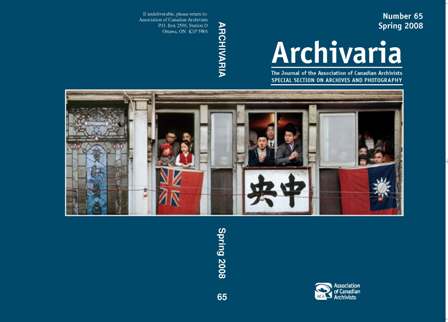An Inconvenient Truth? Scientific Photography and Archival Ambivalence
Abstract
From the earliest days of the photograph to the present, its value has been recognized by the scientific community to help them document and understand the natural world. Photography archivists at Library and Archives Canada (and its predecessors) have long recognized the importance of survey photography in documenting various attempts to conquer the vast geography of Canada. But more often than not, such photographs were acquired for their cultural and historical (nation building) importance rather than their scientific utility. Archivists’ education and training has often led us to neglect the potential scientific value of such records.
The Mountain Legacy Project/Rocky Mountain Repeat Photography Project is a partnership project between Library and Archives Canada and the Environmental Studies Department of the University of Victoria. In brief, the project uses historical phototopographic survey images (held at LAC) taken in the Rocky Mountains, and exact repeat images taken today, to allow scientists to conduct detailed comparativechange analysis on the mountain landscape. With the increasing attention being paid to climate change in Canada and around the world, the project is timely. However, the creation and use of the historic images opens up a number of broader questions for the archival community. The large collection of photographs raises longstanding issues about appraisal and acquisition decisions regarding scientific records, and the value of such records. At the same time, these photographs open up a window to understanding a sometimes neglected yet foundational tradition in documentary photography: the scientific photograph.
RÉSUMÉ
Depuis les tout premiers jours de la photographie jusqu’à nos jours, sa valeur a été reconnue par la communauté scientifique afin de lui permettre de documenter et de comprendre le monde naturel. Les archivistes de la photographie à Bibliothèque et Archives Canada (et ses prédécesseurs) ont longtemps reconnu l’importance de la photographie d’arpentage afin de décrire les dif férents efforts pour conquérir la vaste géographie du Canada. Dans la plupart des cas, cependant, des photographies de ce genre ont été acquises pour leur importance culturelle et historique (« nation building »), plutôt que pour leur utilité scientifique. L’éducation et la formation des archivistes les ont souvent menés à négliger la valeur scientifique potentielle de tels documents.
L’initiative Mountain Legacy Project/Rocky Mountain Repeat Photography Project est un projet de partenariat entre Bibliothèque et Archives Canada et le Département d’études environnementales de la University of Victoria. En bref, ce projet se sert d’images d’arpentage photo-topographiques historiques des Rocheuses (conservées à BAC) et des images contemporaines de ces mêmes emplacements, afin de permettre aux scientifiques de mener une analyse comparée détaillée des changements survenus au paysage montagneux. Puisqu’on s’intéresse davantage au Canada et dans le monde entier au changement climatique, le projet est d’actualité. Cependant, la création et la consultation des images historiques engendrent un nombre de questions plus larges pour la communauté archivistique. La grande collection de photographies suscite des questions par rapport à l’évaluation et l’acquisition des documents scientifiques et la valeur de ce genre de documents qui ne sont pas nouvelles. En même temps, ces photographies ouvrent une nouvelle fenêtre qui permet de mieux comprendre une tradition fondamentale de la photographie documentaire parfois négligée, la photographie scientifique.
Authors of manuscripts accepted for publication retain copyright in their work. They are required to sign the Agreement on Authors' Rights and Responsibilities that permits Archivaria to publish and disseminate the work in print and electronically. In the same agreement, authors are required to confirm that "the material submitted for publication in Archivaria, both in its paper and electronic versions, including reproductions of other works (e.g. photographs, maps, etc.) does not infringe upon any existing copyright." Authors of manuscripts accepted for publication retain copyright in their work and are able to publish their articles in institutional repositories or elsewhere as long as the piece is posted after its original appearance on archivaria.ca. Any reproduction within one year following the date of this agreement requires the permission of the General Editor.





